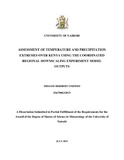| dc.description.abstract | Climate related extremes such as floods and droughts have presented significant challenges to
nations worldwide and especially developing countries. Kenya is not an exception to the effect of
the periodic extremes in temperature and precipitation events which have drastically affected its
people as well as the economy. It is necessary to investigate the past, current and future
characteristics of these extreme events so as to come up with concrete information that can
provide the basis for effective contingency planning.
The main objective of the study was to determine the past, present and future changes in extreme
temperature and rainfall over Kenya using the Coordinated Regional Downscaling Experiment
(CORDEX) model outputs. Data employed in this study included daily observed rainfall and
temperature datasets from IGAD Climate Prediction and Applications Centre (ICPAC), gridded
datasets from Climate Research Unit (CRU) and the CORDEX model outputs. The study utilized
extreme indices to determine the observed and modeled temperature and rainfall extremes.
Methods for assessing the skill of the models included spatial and time series analysis, difference
plots and correlation analysis.
Climate extreme indices indicate that maximum and minimum temperatures have decreased in
the western parts of the country. The diurnal temperature range has increased in the coastal parts
of Kenya; however, there has been a decrease in the urban centers especially in Nairobi and
Kisumu. Mean monthly maximum and minimum temperatures have increased in the arid and
semi-arid parts of Kenya. Rainfall indices indicate that dry days have decreased while wet days
have increased in some parts of the northern arid and semi-arid regions. Total precipitation has
increased in most of the arid and semi-arid regions and has decreased in urban centers and
western parts of Kenya. Extreme wet days have slightly increased over the central highlands.
Most models suggest an increase in the future number of wet days in the southern arid and semiarid
parts of Kenya during the MAM season. Decrease in wet days is expected in areas that
usually receive rainfall during the JJA season. Much of the arid and semi-arid regions are
expected to experience increase in wet days in the future during the OND season. Increase in the
number of extreme wet days is expected in the western parts of Kenya during the MAM, JJA and
OND seasons. Much of the country is expected to warm by at least 20% of the 90th percentile
baseline threshold in all the seasons.
These findings provide the much needed information to stakeholders to put in place adaptation
strategies that will help protect the lives and livelihoods of people living in places where
significant changes are expected considering the RCP4.5 scenario. Future studies should perform
the necessary bias corrections before proceeding with further analysis of projection data from
these models. | en_US |

